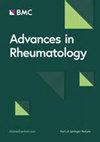Evaluation of core decompression outcome in systemic lupus erythematosus with hip osteonecrosis: a retrospective cohort study
IF 2
4区 医学
Q3 RHEUMATOLOGY
引用次数: 0
Abstract
Osteonecrosis is a major cause of morbidity for patients with systemic lupus erythematosus (SLE). Although core decompression is an approved and trusted technique to prevent further joint deterioration, this surgical method seems to be less beneficial for SLE patients. We aimed to evaluate the outcomes of core decompression in SLE patients with primary stages of femoral head osteonecrosis. In this study, 23 patients (39 affected hip joints) with osteonecrosis of the femoral head with stage II of the disease, based on the Ficat-Arlet classification system, underwent core decompression. Also, patients demographic characteristics, clinical data, medication history, comorbidities, immunological findings, hip plain radiographs, history of total hip arthroplasty after core decompression, and patients satisfaction with joint function according to the Oxford hip score questionnaire were obtained. In the study, 53.8% of affected joints showed signs of radiographic deterioration in follow-up imaging. Sixty-one and a half percent (61.5%) of patients had unsatisfactory joint performance. A third (33.3%) of affected hip joints underwent total hip arthroplasty up to 5 years from core decompression. SLE patients with a history of receiving bisphosphonate were 83.2% less dissatisfied with their joint function than patients without a history of bisphosphonate use (P < 0.02). Of the 23 studied cases, the mean cumulative dose of prednisolone before and after core decompression surgery was 46.41 mg and 14.74 mg respectively. Besides, one case (2.6%) that had a high anti-phospholipid antibodies level during follow-up did not have any radiographic deterioration, and 9 cases (23.1%) had some degrees of radiographic deterioration. The patients group that used bis-phosphonate, had a higher level of satisfaction with joint function after core decompression. Patients with high-level anti-phospholipid antibodies are related to a poor prognosis after core decompression.系统性红斑狼疮伴髋关节骨坏死患者核心减压效果评估:一项回顾性队列研究
骨坏死是系统性红斑狼疮(SLE)患者发病的一个主要原因。尽管核心减压术是一种被认可且值得信赖的防止关节进一步恶化的技术,但这种手术方法似乎对系统性红斑狼疮患者的益处较小。我们旨在评估股骨头坏死原发阶段系统性红斑狼疮患者接受核心减压术的效果。在这项研究中,23 名(39 个受累髋关节)股骨头坏死患者(根据 Ficat-Arlet 分类系统划分为 II 期)接受了核心减压术。此外,研究还了解了患者的人口统计学特征、临床数据、用药史、合并症、免疫学检查结果、髋关节平片、核心减压术后全髋关节置换术史,以及根据牛津髋关节评分问卷调查的患者关节功能满意度。研究结果显示,53.8%的受影响关节在随访影像学检查中出现恶化迹象。61.5%的患者(61.5%)对关节功能不满意。三分之一(33.3%)的受影响髋关节在核心减压术后五年内接受了全髋关节置换术。与无双膦酸盐使用史的患者相比,有双膦酸盐使用史的系统性红斑狼疮患者对关节功能的不满意度降低了83.2%(P < 0.02)。在研究的 23 例患者中,核心减压手术前后泼尼松龙的平均累积剂量分别为 46.41 毫克和 14.74 毫克。此外,1 例(2.6%)在随访期间抗磷脂抗体水平较高的患者没有出现任何影像学恶化,9 例(23.1%)出现了一定程度的影像学恶化。使用双膦酸盐的患者对核心减压术后关节功能的满意度较高。高水平抗磷脂抗体患者在核心减压术后预后较差。
本文章由计算机程序翻译,如有差异,请以英文原文为准。
求助全文
约1分钟内获得全文
求助全文
来源期刊

Advances in Rheumatology
Medicine-Rheumatology
CiteScore
4.00
自引率
4.30%
发文量
41
审稿时长
53 weeks
期刊介绍:
Formerly named Revista Brasileira de Reumatologia, the journal is celebrating its 60th year of publication.
Advances in Rheumatology is an international, open access journal publishing pre-clinical, translational and clinical studies on all aspects of paediatric and adult rheumatic diseases, including degenerative, inflammatory and autoimmune conditions. The journal is the official publication of the Brazilian Society of Rheumatology and welcomes original research (including systematic reviews and meta-analyses), literature reviews, guidelines and letters arising from published material.
 求助内容:
求助内容: 应助结果提醒方式:
应助结果提醒方式:


